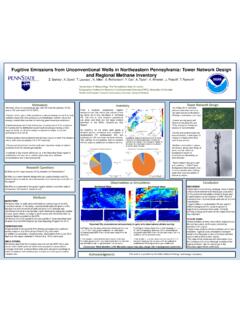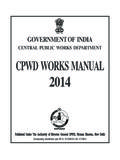Transcription of Availability Solar Radiation Data - Earth System Research ...
1 Availability Solar Radiation data Solar Radiation over india by A Mani, handbook of Solar Radiation by A Mani and Solar Radiant Energy over india (2009) by Ministry of New and Renewable Energy ,GOI. NISE(SEC)-NREL NASA Very limited measured Solar Radiation data is available for the country. IMD - Solar Radiation measuring network Figure 2 Spatial Distribution of Solar Radiation Monitoring Stations in the Existing Network of IMD Solar Radiation over india by A Mani, handbook of Solar Radiation by A Mani and Solar Radiant Energy over india (2009) by MNRE. india Meteorological Department (IMD) Stations. Commenced from 2010 in staggered phases Initiated by Ministry of New and Renewable Energy National Institute of Wind Energy Implemented by An unique project on Ground Measurement of Solar Radiation data Installation To Install Solar Radiation and Weather data measuring station To create countrywide organizational structures for Solar Radiation data collection System .
2 Solar Atlas To develop a strong database of accurate Solar Radiation data To develop Solar Radiation atlas of india . Dissemination To make Solar data Products ready for Solar developers, FIs, Policy makers, R & D institutions etc Support for marketing and bankability of Solar projects Application segment Target for Phase I (2010-13) Target for Phase 2 (2013-17) Target for Phase 3 (2017-22) Solar collectors 7 million sq. meter 15million sq. meter 20 Million sq. meter Off grid Solar application 200 MW 1000 MW 2000 MW Utility grid power, including roof top 1000-2000 MW 4000-10000 MW 20000 MW Jawaharlal Nehru National Solar per the updated targets the National Solar Mission, india aims to have an installed Solar power capacity of 100 GW by 2022.
3 GW capacity will include 40 GW rooftop Solar power capacity and 60 GW utility-scale Solar power projects data QUALITY PYRAMID INSTRUMENT SELECTION SITE SELECTION AND INSTALLATION MEASUREMENTS Calibration QUALITY CONTROL data Typical SRRA Station Lightening arrestor tower 6 m wind mast PV panel Rain gauge Solar tracker at m SRRA Stations-Phase-I Dedicated SRRA stations Phase I 51 Phase II 60 MEDA 06 AMS 04 Total 121 Advanced Measurement Station(AMS) Sun Photometer on Solar tracker @ m 6m Tower Lightening Arrestor Scatterometer Direct Beam Filter Spectrometer-YES, USA Scatterometer - Envirotech USA Albedometer-Hukseflux-SRA20 Pyrgeometer-Hukseflux-IR20 Silicon Pyranometer SRRA-Servers comprising of Primary, Secondary and Web server receiving & archiving data from all SRRA stations: 1 s data sampling at stations averaged to 1 min.
4 SolMap-Servers for quality check (QC), assessment and SRRA product generation. SolMap Servers SRRA Servers CWET SRRA Station SRRA Screen Shot Sampling period Averaging period Duration 10 sec 10 min Up to Nov 2011 1 sec 10 min Up to August 2012 1 sec 1 min From August 2012 till date For Solar Radiation parameters, the applied quality control is based on Baseline Surface Radiation Network (BSRN) rules by the World Meteorological Organisation(WMO), elaborated by the Management and Exploitation of Solar Resource Knowledge(MESOR) Field Experiences 1. Basic Gap Filling Gap filling methodology depends on a) Availability of three Solar Radiation components: Global Horizontal Irradiance (GHI) Diffuse Horizontal Irradiance (DHI) Direct Normal Irradiance (DNI) Case 1: gap for one component (GHI only or DHI only or DNI only) Case 2: gap for two components (DHI and DNI) Case 3: gap for all three Solar Radiation components (GHI, DHI and DNI) b) the duration (length) of the gap.
5 Up to 3 hours greater than 3 hours Gap Filling Procedures Basic Gap Filling L3 Basic Gap Filling Basic gap filling procedures developed under SRRA/SolMap for data products The methodology depends on the Availability of 3 Radiation parameters and duration At the moment basic gap filling is done with 1 hour resolution time series Advanced gap filling techniques using satellite derived values are being implemented under SolMap project now and expected to be operational in a few months The impacts of basic gap filling was tested with al 51 stations of SRRA phase 1 Accuracy of basic gap filling method was tested by creating artificial gaps Mean bias of about 3% observed over GHI, DNI, DHI over all types of gaps This accuracy is close to the accuracy of the measuring instruments indicating the gap filled values stay within tolerance limits Basic Gap filling only up to 3 hrs Kalpana Satellite (ISRO) Irradiance data Linear interpolation techniques To improve the accuracy of basic gap filling for periods greater than 3 hours Basic Gap filling Advanced Gap filling SRRA L 2 data SRRA products: example of L2 ASCII data in 1 min Online data from C-Wet Solar Website SRRA error statistics Most frequent shortcomings DNI.
6 <- Missing values on average % <- Coherence test on average % Tracking error on average only % 0% 2% 4% 6% 8% 10% 12% 14% 16% 18% Amarsaga Cwet Santalp Kota Karaikud Ramanath Bodana Mathania Sirohi Bhogat Phalodi Kayathar Balotra Jambua Churu Ajmer Jodhpur Keshod Pokhran Pondiche Bagora Vartej Idar KotadaP Karad Chandrod Erode Shegaon Tharad Sadodar Trichy Leh Pandharp GandhiNa Bilaspur Vellore Gurgoan Chilakap Bellary Rajahmun Belgaum Gulbarga Kadiri Medak Mandsaur Bijapur Tirupati Guruzala Rajgarh ChitraDu Neemuch Error DNI: missing values (flag 0) 0% 2% 4% 6% 8% 10% 12% 14% 16% 18% Amarsaga Cwet Santalp Kota Karaikud Ramanath Bodana Mathania Sirohi Bhogat Phalodi Kayathar Balotra Jambua Churu Ajmer Jodhpur Keshod Pokhran Pondiche Bagora Vartej Idar KotadaP Karad Chandrod Erode Shegaon Tharad Sadodar Trichy Leh Pandharp GandhiNa Bilaspur Vellore Gurgoan Chilakap Bellary Rajahmun Belgaum Gulbarga Kadiri Medak Mandsaur Bijapur Tirupati Guruzala Rajgarh ChitraDu Neemuch Error DNI.
7 Coherence test (flag 5) Error Percentage (2013) State GHI DNI DHI flagged correct flagged incorrect flagged correct flagged incorrect flagged correct flagged incorrect [%] [%] [%] [%] [%] [%] Jammu &Kashmir Tamil Nadu Rajasthan Pondicherry Madhya Pradesh Maharashtra Karnataka Harayana Gujarat Chhattisgarh Andhra Pradesh SRRA Phase I Performance(51 Stations) Solar ATLAS 16 years of Satellite derived maps (1999-2014) were procured from M/S 3 Tier by competitive bidding. Developed of Quality Assessment Protocol for validation of long term Solar irradiance data of 3 Tier against SRRA ground measurements.
8 Analysis, quality check and comparison of Satellite based time series data for 115 locations against SRRA stations ground data for preparation of Solar Radiation Map of india . Measurements from 54 SRRA stations spread over india were used to adjust satellite derived estimates on a monthly basis. The final map products were validated against the remaining 61 SRRA stations. Using both ground measured Solar Radiation data of three years and long term satellite data , Solar Atlas of india has been prepared. The atlas consists of 90 Solar Radiation maps with spatial resolution of 3km X 3km, 30 maps each for GHI, DNI and DHI which comprises of log term averages, long term monthly average, annual average, annual variability maps and uncertainty maps.
9 3 Tier Satellite data Sources Satellite Platform used Meteosat-5 covered india from July 1998 through February 2007. Meteosat-7 covers india from February 2007 through February 2014 and is in continuing service. Both satellites are from the first generation of Meteosat satellite and the visible band ( m) is used. Geo-location of Meteosat-5 from around 2005 onwards was difficult due to difficulties to stabilize the satellites orbit. Thus, likelihood of erroneous data is higher until Meteosat-7 took over in 2007 Satellite Position Meteosat-5 from mid 1998 was located at approx. 63 E, while M-7 from late 2006 was at around 57 E Temporal coverage of Satellite_ Start date/ End date and Operational duration Meteosat 5 02/05/1991 16/04/2007, Indian Ocean position started on 01/07/1998.
10 Meteosat 7 02/09/1997 to 01/31/2014 (ongoing), Indian Ocean position started on 01/11/2006. Input data for the Solar Radiation Atlas of india 3 TIER satellite-derived monthly maps of india & time-series for SRRA stations 1999 to 2014 => 16 years Delivered in March 2015 SRRA ground truth Phase 1: 51 stations starting 2011, operational since 2012 Phase 2: 64 + 6 MEDA stations stations starting 2014 Total: 115 - 121 stations => 2012 to 2014 => to >3 years long-term satellite data ground-measured data + By extending the sat- data to end of 2014 better overlap reached and with SRRA Phase 2 many more stations available Processing of Solar maps Processing of spatial correction matrices from geostatistical interpolation of satellite data to measured on hourly base monthly averages SRRA L3 data sat-time-series st.













